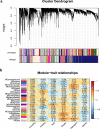Identification of stress-related genes by co-expression network analysis based on the improved turbot genome
- PMID: 35768602
- PMCID: PMC9243025
- DOI: 10.1038/s41597-022-01458-4
Identification of stress-related genes by co-expression network analysis based on the improved turbot genome
Abstract
Turbot (Scophthalmus maximus), commercially important flatfish species, is widely cultivated in Europe and China. With the continuous expansion of the intensive breeding scale, turbot is exposed to various stresses, which greatly impedes the healthy development of turbot industry. Here, we present an improved high-quality chromosome-scale genome assembly of turbot using a combination of PacBio long-read and Illumina short-read sequencing technologies. The genome assembly spans 538.22 Mb comprising 27 contigs with a contig N50 size of 25.76 Mb. Annotation of the genome assembly identified 104.45 Mb repetitive sequences, 22,442 protein-coding genes and 3,345 ncRNAs. Moreover, a total of 345 stress responsive candidate genes were identified by gene co-expression network analysis based on 14 published stress-related RNA-seq datasets consisting of 165 samples. Significantly improved genome assembly and stress-related candidate gene pool will provide valuable resources for further research on turbot functional genome and stress response mechanism, as well as theoretical support for the development of molecular breeding technology for resistant turbot varieties.
© 2022. The Author(s).
Conflict of interest statement
The authors declare no competing interests.
Figures



Similar articles
-
Genome-Wide Identification and Involvement in Response to Biotic and Abiotic Stresses of lncRNAs in Turbot (Scophthalmus maximus).Int J Mol Sci. 2023 Nov 1;24(21):15870. doi: 10.3390/ijms242115870. Int J Mol Sci. 2023. PMID: 37958851 Free PMC article.
-
A combined strategy involving Sanger and 454 pyrosequencing increases genomic resources to aid in the management of reproduction, disease control and genetic selection in the turbot (Scophthalmus maximus).BMC Genomics. 2013 Mar 15;14:180. doi: 10.1186/1471-2164-14-180. BMC Genomics. 2013. PMID: 23497389 Free PMC article.
-
Transcriptome Analysis for Identification of Genes Related to Gonad Differentiation, Growth, Immune Response and Marker Discovery in The Turbot (Scophthalmus maximus).PLoS One. 2016 Feb 29;11(2):e0149414. doi: 10.1371/journal.pone.0149414. eCollection 2016. PLoS One. 2016. PMID: 26925843 Free PMC article.
-
A genome-wide association study, supported by a new chromosome-level genome assembly, suggests sox2 as a main driver of the undifferentiatiated ZZ/ZW sex determination of turbot (Scophthalmus maximus).Genomics. 2021 Jul;113(4):1705-1718. doi: 10.1016/j.ygeno.2021.04.007. Epub 2021 Apr 8. Genomics. 2021. PMID: 33838278
-
Turbot (Scophthalmus maximus) vs. VHSV (Viral Hemorrhagic Septicemia Virus): A Review.Front Physiol. 2016 May 26;7:192. doi: 10.3389/fphys.2016.00192. eCollection 2016. Front Physiol. 2016. PMID: 27303308 Free PMC article. Review.
Cited by
-
Genome-Wide Identification and Interaction Analysis of Turbot Heat Shock Protein 40 and 70 Families Suggest the Mechanism of Chaperone Proteins Involved in Immune Response after Bacterial Infection.Int J Mol Sci. 2024 Jul 21;25(14):7963. doi: 10.3390/ijms25147963. Int J Mol Sci. 2024. PMID: 39063205 Free PMC article.
-
Genome-Wide Identification and Involvement in Response to Biotic and Abiotic Stresses of lncRNAs in Turbot (Scophthalmus maximus).Int J Mol Sci. 2023 Nov 1;24(21):15870. doi: 10.3390/ijms242115870. Int J Mol Sci. 2023. PMID: 37958851 Free PMC article.
-
Genome-Wide Identification, Molecular Characterization, and Involvement in Response to Abiotic and Biotic Stresses of the HSP70 Gene Family in Turbot (Scophthalmus maximus).Int J Mol Sci. 2023 Mar 23;24(7):6025. doi: 10.3390/ijms24076025. Int J Mol Sci. 2023. PMID: 37046999 Free PMC article.
-
High-quality Japanese flounder genome aids in identifying stress-related genes using gene coexpression network.Sci Data. 2022 Nov 16;9(1):705. doi: 10.1038/s41597-022-01821-5. Sci Data. 2022. PMID: 36385241 Free PMC article.
-
Effects of the Exopolysaccharide from Lactiplantibacillus plantarum HMX2 on the Growth Performance, Immune Response, and Intestinal Microbiota of Juvenile Turbot, Scophthalmus maximus.Foods. 2023 May 19;12(10):2051. doi: 10.3390/foods12102051. Foods. 2023. PMID: 37238869 Free PMC article.
References
-
- Bjørndal, T. & Øiestad, V. J. W. P. The development of a new farmed species: production technology and markets for turbot. Working Paper (2010).
-
- Lei JL, Liu XF, Guan CT. Turbot culture in China for two decades: achievements and prospect. Progress in Fishery Sciences. 2012;33:123–130.
Publication types
MeSH terms
Grants and funding
LinkOut - more resources
Full Text Sources
Miscellaneous

